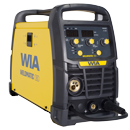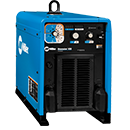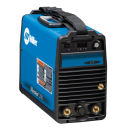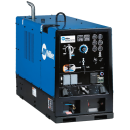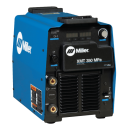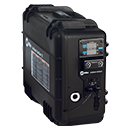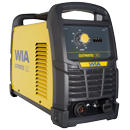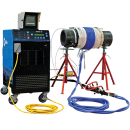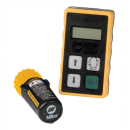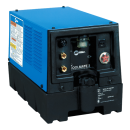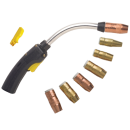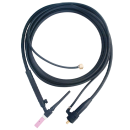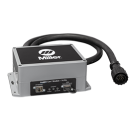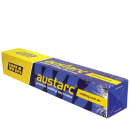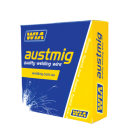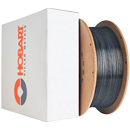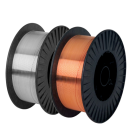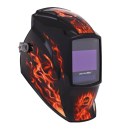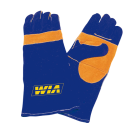Summary
While undertaking preheat and post-weld heat treating work for the Longford Gas Conditioning Plant, Wood Group PSN saved $1 million in contracting fees, nearly 150 working hours, and delivered improved safety outcomes, thanks to the Miller Pro Heat 35 Induction Heating system and the training and support from Welding Industries of Australia (WIA).
Introduction
Oil and gas production in Australia has more than doubled since 19981, creating thousands of jobs and contributing to both local energy needs and a thriving export market.
But as conventional gas reserves decline, the industry is increasingly tapping into other, harder to reach sources2,resulting in higher production and processing costs. In response, oil and gas producers are looking for savings across all their operations -- and this includes the construction of new facilities.
To remain competitive on the market today, construction and engineering management companies like Wood Group PSN must deliver quality results on time and on budget, while avoiding health and safety pitfalls. While the safety record is improving, construction, commissioning and decommissioning remain the most dangerous activities in the oil and gas sector. Statistics from the Australian Petroleum Production & Exploration Association (APPEA) show that in 2013, construction, commissioning and decommissioning work accounted for 270 reported incidents of injury3, or 46.2 percent of the total.
The Task
In April 2014, Wood Group PSN won a contract to provide brownfield engineering, procurement and construction service support at the Longford Gas Conditioning Plant Project for Esso Australia.
Part of Wood Group PSN’s responsibilities was to establish a pair of 1200m long pipes to bring raw gas from the offshore facilities to the gas conditioning plant.
The company’s engineers laid down two 600 nominal bore pipes with 32mm wall thickness. One pipe would carry untreated, raw gas to the plant, while treated gas would flow through the other.
The pipe sections would be welded together using a combination of gas metal arc welding and flux-cored arc welding. But each of the 76 welds would require preheating and post-weld heat treatments, to ensure the metallurgical integrity of the pipes would not be compromised by the temperature fluctuations caused by the welding work.
“When we flow cold gas through the pipes, we need to ensure that it won’t crack due to thermal or mechanical shock,” explained David Barry, Construction Welding Superintendent at Wood Group PSN.
According to David, strict statutory codes and scientific tests govern this type of welding work.
“Before we start welding, we go through all manner of welding procedure qualifications, proving all the equipment, proving our welding methodology, proving we’ve got enough preheat so it doesn’t cool too quickly, proving that our post-weld heat treatment is correct and the results we achieve meet the requirements,” he said.
Bringing it in-house
Normally, preheat and post-weld heat treatments are considered complex specialist tasks, requiring a third party contractor with resistance-type heating equipment.
But there are both risks and costs involved in bringing in third party contractors on site.
“Contractors sometimes aren’t familiar with the requirements, haven’t received the proper training, or have no experience working in a major hazard facility,” David said.
Having to work around their schedules also added to the cost, and made it difficult to manage other parts of projects.
“When we have no need for them on site, we are still paying for them. In contrast, when we self-perform, if we finish the preheating or post-weld heat treating, we can give them another task to do.”
When the team learned about the Miller Pro Heat 35 Induction Heating system from WIA, they knew that it would enable them to bring the preheating and post-weld heat treatment work in-house and still deliver the same results, but in a faster, more cost-effective and safer way.
WIA helped smooth the way by providing comprehensive training and support.
“The training process started when WIA first introduced us to the equipment. We worked very closely with them programming the machines, setting up the hardware on the pipes, etc,” David said.
“As we drew closer to commencing production welding, WIA came down for a few days to work with the engineers who would be doing the work, and ran them through some formal training in the use of the equipment.”
Thanks to the ease of use of the Miller induction heating system, and the training provided by WIA, Wood Group PSN was able to quickly build up its inhouse preheating and post-heat treatment expertise, saving an estimated $1 million in contracting fees.
Faster treatment
One big advantage that induction heating has over the traditional resistance approach is its ability to heat the material consistently and quickly.
“With the induction equipment, we can achieve our 80°C preheat temperature in 10-15 minutes. Resistance type equipment would take 30 to 35 minutes, depending on the ambient temperature,” David explained.
In post-weld heat treatments, the rate of temperature rise is regulated. But those limits only apply once temperatures soar above 400°C.
“So we can get up to 400°C as quick as we like,” he said. “We saved a lot of time there by getting up to 400°C in 25 minutes with the induction method. Conventional equipment would require 2 hours.”
Multiplied across the 76 welding cycles for the project, the team saved more than 145 hours on the preheat and heat treatment operations.
Proving the solution
But speed isn’t everything. David and his team had to prove the case for the use of the Miller induction equipment to both internal decision makers within Wood Group PSN, and the client.
“We took quite a while to win our people and the client over to the equipment,” David said. “We went through a number of mock-ups and demonstrations and lots of mechanical testing to show the results, and lots of calculations demonstrating the commercial savings we would get by self-performing induction heating.”
WIA performed extensive preliminary trials both on and off site for the stakeholders involved. It demonstrated how the equipment would be set up and used to heat up a piece of pipe, as well as the speed of the equipment.
Another key feature that WIA demonstrated during the trials was the digital recording capability that allowed welding engineers to track and document the changes in temperature during the procedure.
“When we are preheating, we have a minimum preheat temperature of 80°C. We placed a number of thermocouples on the piece of pipe. The digital recorder that sits on top of the Pro Heat machine showed that we maintained that temperature,” David explained.
“Come time for the post-weld heat treatment, we could show the chart documenting our rate of rise to the soak temperature of 650°C.”
“The recorder let us show that we haven’t heated it up too quickly or too slowly, that we have stayed in that soak temperature for a specified period of time, and that we cooled down the piece at the specified rate.”
Following the preliminary trials, the team tested the entire procedure on an actual project pipe.
“We welded a section with preheat, performed postweld heat treatment on that weld using the induction equipment, then put the weld through the whole suite of mechanical testing, to prove that the induction method produces the required results, even though it does things quicker,” David said.
Health and safety
Ignition sources like open flames and hot elements, while dangerous by themselves, can be especially deadly when combined with the volatile materials and confined spaces found in the oil and gas industry. Thus, engineers undertaking welding work within the oil and gas sector must ensure compliance with a raft of safety legislations4.
“We are working in a light plant, so most of the time we are working in habitats measuring around 4m x 4m. We need to contain any sparks and ignition sources,” David said.
In traditional resistance heating methods, engineers install ceramic heat pads on the surface of the pipe, wire them up, then wrap them in synthetic mineral fibre (SMF) insulation.
The pads then heat up, relying on the surface contact to heat the pipes. This results in an intense heat source that not only exposes personnel around the equipment to radiant heat, but is a high-risk ignition source.
Miller Pro Heat’s non-contact heating method, which works by generating heat within the material of the pipe, rather than heating up the pad, helped Wood Group PSN eliminate the issue.
“With the induction method, there’s nothing glowing, so no potential ignition source,” explained David.
The high temperatures generated by the electrical wires and ceramic pads in the resistance heating method can also quickly deteriorate the SMF insulation, which break down into particulates, resulting in the added need for respiratory protection.
“The SMF ends up flying around in the air, and you get issues with people breathing it, etc,” David said.
“Whereas with the induction method, we just wrap the pad around, plug it in, and go. Because there’s no heat present on the surface against the pad, the pad doesn’t deteriorate like the SMF does.”
Conclusion
With easy set-up, and features like on-board temperature control, the Miller Pro Heat 35 Induction Heating system helped David and his team at Wood Group PSN take control of the preheat and postwelding heat treatment process at the Longford Gas Conditioning Plant project. This yielded faster results, lower costs, and improved safety outcomes -- without compromising on the quality of work.
The key to achieving this outcome, David suggests, was to take full advantage of the training and advice from WIA.
“Invest a little at the front end, and as we proved, there are many dollars to be saved by the use of this product,” David said. “The results you achieve with it easily exceed the results from conventional equipment.”
REFERENCES
1 Page 5, APPEA, Key Statistics 2015
http://www.appea.com.au/wp-content/uploads/2015/05/APPEA_Key-Stats15_web.pdf
2 Australian Government Department of Industry and Science, Gas Market Development
http://www.industry.gov.au/Energy/EnergyMarkets/GasMarketDevelopment/Pages/default.aspx
3 Page 4, APPEA, Health, Safety & Environment Report 2013-2014
http://www.appea.com.au/wp-content/uploads/2015/06/HSE_2013-14_Web_.pdf
4 Page 19, Safe Work Australia Welding Processes Code of Practice
http://www.safeworkaustralia.gov.au/sites/SWA/about/Publications/Documents/703/Welding%20Processes.doc






